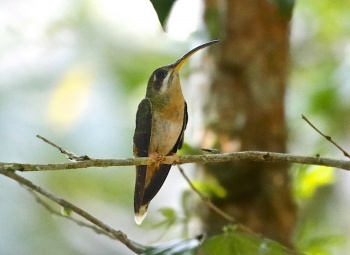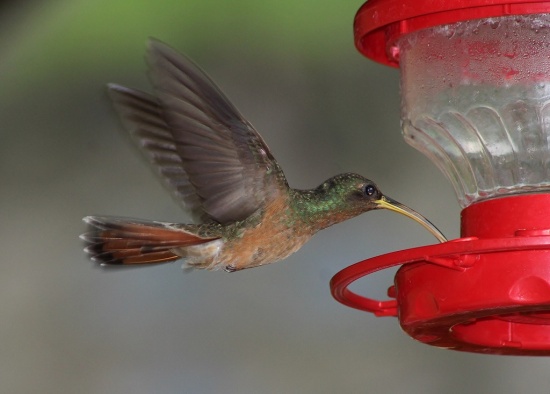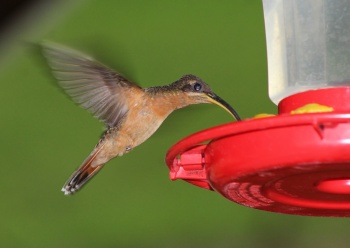(→External Links: Additional GSearch for common name. GSearch Checked template) |
|||
| (7 intermediate revisions by 3 users not shown) | |||
| Line 1: | Line 1: | ||
| − | + | [[Image:Rufous - breasted Hermit male 1.JPG|thumb|550px|right|Male<br />Photo © by {{user|DABS|DABS}}<br />Petit Valley, [[Trinidad]], July 2017]] | |
| − | [[Image:Rufous- | + | ;[[:Category:Glaucis|Glaucis]] hirsutus |
| + | |||
==Identification== | ==Identification== | ||
| − | + | [[Image:Rufous-breasted Hermit Glaucis hirsutus insular Manu Lodge Peru.jpg|thumb|350px|right|Female<br />Photo © by {{user|Stanley+Jones|Stanley Jones}}<br />Manu Lodge, Río Madre de Dios, Madre de Dios Department, [[Peru]], September 2018]] | |
| + | 10–12 cm (4-4¾ in)<br /> | ||
| + | Bronze-green upperparts and bright cinnamon underparts.<br /> | ||
| + | The central tail feathers are colored like the back except for white tips, while the rest of the rounded tail has feathers that are rufous with black subterminal band and white tips.<br /> | ||
| + | The head shows a dusky stripe through the eye. The bill is long (1.5 inches) and curved, with a black upper mandible and a '''yellow''' lower mandible (on male, the upper mandible should also have yellow streaks)<br /> | ||
| + | Both sexes have [[Topography#Heads|superciliary]] and [[Topography#Heads|moustachial]] streaks, but these are far more pronounced in the female. | ||
==Distribution== | ==Distribution== | ||
| − | [[Panama]] to [[Colombia]], [[Brazil]], the [[Guianas]], [[Venezuela]], and [[Trinidad]], [[Tobago]] and [[Grenada]]. | + | [[Central America|Central]] and [[South America]]: found from [[Panama]] to [[Colombia]], [[Brazil]], the [[Guianas]], [[Venezuela]], and [[Trinidad]], [[Tobago]] and [[Grenada]]. |
==Taxonomy== | ==Taxonomy== | ||
| − | Rufous-breasted Hermit was previously considered conspecific with [[Bronzy Hermit]] | + | Rufous-breasted Hermit was previously considered [[Dictionary_A-C#C|conspecific]] with [[Bronzy Hermit]] |
| + | ====Subspecies==== | ||
| + | [[Image:Rufous - breasted Hermit female .JPG|thumb|350px|right|Female<br />Photo © by {{user|DABS|DABS}}<br />Petit Valley, [[Trinidad]], 16 July 2017]] | ||
| + | There are 2 subspecies<sup>[[#References|[1]]]</sup>: | ||
| + | *''G. h. insularum'': | ||
| + | :*[[Grenada]], [[Trinidad]] and [[Tobago]] | ||
| + | *''G. h. hirsutus'' | ||
| + | :*[[Panama]] to western [[Colombia]], [[Venezuela]], [[Guianas]], [[Brazil]], northern [[Bolivia]] | ||
| + | |||
==Habitat== | ==Habitat== | ||
Forests and secondary growth, and edges, sometimes even to more open areas near the forest. Found at less than 1000 meters in northern Venezuela. | Forests and secondary growth, and edges, sometimes even to more open areas near the forest. Found at less than 1000 meters in northern Venezuela. | ||
==Behaviour== | ==Behaviour== | ||
Described as inquisitive and aggressive, mostly seen alone. | Described as inquisitive and aggressive, mostly seen alone. | ||
| + | ====Diet==== | ||
| + | Their main diet consists of nectar. They readily visit feeders. | ||
| + | ==References== | ||
| + | #{{Ref-Clements6thAug19}}#Hinkelmann, C., P. F. D. Boesman, and G. M. Kirwan (2020). Rufous-breasted Hermit (Glaucis hirsutus), version 1.0. In Birds of the World (J. del Hoyo, A. Elliott, J. Sargatal, D. A. Christie, and E. de Juana, Editors). Cornell Lab of Ornithology, Ithaca, NY, USA. https://doi.org/10.2173/bow.rubher.01 | ||
| + | #Birdforum Member observations | ||
| + | {{ref}} | ||
==External Links== | ==External Links== | ||
| − | {{GSearch|Glaucis+ | + | Search the Gallery using the scientific name: |
| − | [[Category:Birds]] | + | {{GSearch|Glaucis+hirsut*}} |
| + | Search the Gallery using the common name: | ||
| + | {{GSearch|"Rufous-breasted Hermit"}} | ||
| + | {{GS-checked}} | ||
| + | <br /> | ||
| + | <br /> | ||
| + | |||
| + | [[Category:Birds]] [[Category:Glaucis]] | ||
Latest revision as of 21:04, 6 April 2022
- Glaucis hirsutus
Identification

Photo © by Stanley Jones
Manu Lodge, Río Madre de Dios, Madre de Dios Department, Peru, September 2018
10–12 cm (4-4¾ in)
Bronze-green upperparts and bright cinnamon underparts.
The central tail feathers are colored like the back except for white tips, while the rest of the rounded tail has feathers that are rufous with black subterminal band and white tips.
The head shows a dusky stripe through the eye. The bill is long (1.5 inches) and curved, with a black upper mandible and a yellow lower mandible (on male, the upper mandible should also have yellow streaks)
Both sexes have superciliary and moustachial streaks, but these are far more pronounced in the female.
Distribution
Central and South America: found from Panama to Colombia, Brazil, the Guianas, Venezuela, and Trinidad, Tobago and Grenada.
Taxonomy
Rufous-breasted Hermit was previously considered conspecific with Bronzy Hermit
Subspecies
There are 2 subspecies[1]:
- G. h. insularum:
- G. h. hirsutus
Habitat
Forests and secondary growth, and edges, sometimes even to more open areas near the forest. Found at less than 1000 meters in northern Venezuela.
Behaviour
Described as inquisitive and aggressive, mostly seen alone.
Diet
Their main diet consists of nectar. They readily visit feeders.
References
- Clements, J. F., T. S. Schulenberg, M. J. Iliff, S. M. Billerman, T. A. Fredericks, B. L. Sullivan, and C. L. Wood. 2019. The eBird/Clements Checklist of Birds of the World: v2019. Downloaded from http://www.birds.cornell.edu/clementschecklist/download/
- Hinkelmann, C., P. F. D. Boesman, and G. M. Kirwan (2020). Rufous-breasted Hermit (Glaucis hirsutus), version 1.0. In Birds of the World (J. del Hoyo, A. Elliott, J. Sargatal, D. A. Christie, and E. de Juana, Editors). Cornell Lab of Ornithology, Ithaca, NY, USA. https://doi.org/10.2173/bow.rubher.01
- Birdforum Member observations
Recommended Citation
- BirdForum Opus contributors. (2024) Rufous-breasted Hermit. In: BirdForum, the forum for wild birds and birding. Retrieved 10 November 2024 from https://www.birdforum.net/opus/Rufous-breasted_Hermit
External Links
Search the Gallery using the scientific name:
Search the Gallery using the common name:
GSearch checked for 2020 platform.





